The Garmin GPSMAP 78 brought a major update to the GPSMAP 76 handheld line. Garmin had a huge hit with the 60/76 series, and instead of messing with a winner, they turned their attention to new interfaces, which were introduced on the Colorado series, followed by the touch screen Oregon line. These new units brought the ability to add custom maps and aerial imagery, paperless geocaching, and high-resolution screens, but the latter made them less than bright (although later models like the Oregon 450 have largely solved this problem).
But patience has its rewards and Garmin did well not to rush things. With the 78 (and the landlubber’s 62 series, which shares the same interface), Garmin has married the best features of the 60/76 models, with many of the advantages of the Oregon line. The 78 is the entry-level model in this series, so before we get into the details, lets look at it’s big brothers…
Related models
- Step up to the GPSMAP 78s and you’ll gain user profiles, wireless data sharing, a barometric altimeter and tri-axial electronic compass
- Going even further, the GPSMAP 78sc adds pre-loaded marine charts for the coastal US to the features found on the 78s
- To see how the GPSMAP 78 stands up against other Garmin models, check out my Garmin handheld GPS comparison chart
Garmin GPSMAP 78 display
With transflective TFT screens, the greater the pixel density, the less light that can be reflected back to the user. In order to maintain the bright screen found on the 60/76 series, Garmin left the resolution (160 x 240 pixels) alone. Screen size remains unchanged too, at 1.6 x 2.2”. The 62 and 78 series do enjoy an increased range of colors that can be displayed (65,000 vs. 256 in the 60/76 series). The result is a bright display, not quite as large or as high resolution as the Oregon series, but with much better visibility in a wide range of conditions. I definitely noticed the lower resolution, but these are the tradeoffs you make. Also of note, speaking as the owner of an Oregon 400t, I really didn’t miss the larger screen.
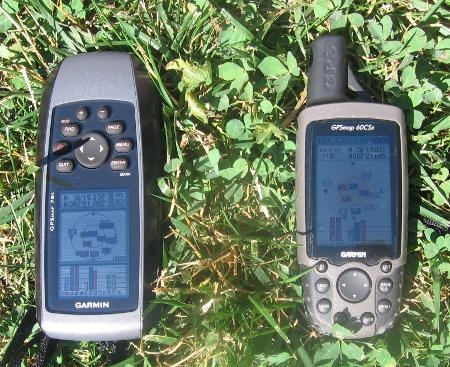
Shown above and below are sun and shade photos of the 78s (which has the same display as the 78) and the older 60CSx, without backlight. It is difficult to capture screen visibility on film, but I would call these two displays comparable under a wide range of conditions.
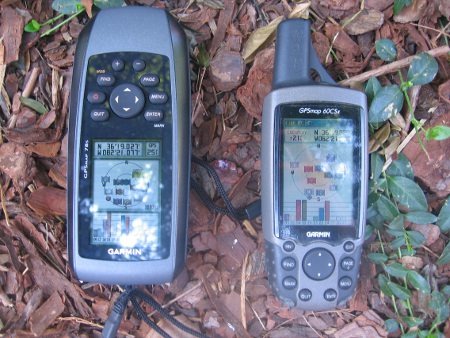
Garmin GPSMAP 78 interface
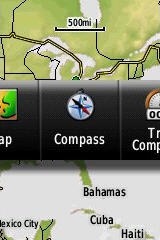 Garmin hit a home run here. They did an excellent job taking the best aspects of the Oregon interface and making it work on a non-touchscreen unit. I think it is actually better than the Oregon except for when it comes to text-entry, where touchscreens excel. This new interface makes it much quicker to navigate main menu items.
Garmin hit a home run here. They did an excellent job taking the best aspects of the Oregon interface and making it work on a non-touchscreen unit. I think it is actually better than the Oregon except for when it comes to text-entry, where touchscreens excel. This new interface makes it much quicker to navigate main menu items.
A Page Ribbon menu appears when you press the Page or Quit buttons (see image at right). Just like on the 60/76 series, these buttons advance through pages in forward or reverse order, respectively.
The Page Ribbon menu item that appears is the next screen in the sequence. After a second or two, that screen will automatically open. Or you can press Enter to go there right away, or continue pressing Page or Quit to advance to other pages in the sequence; stop on one and it will open. Page Ribbon items and their order can be customized.
For boaters
The 78 is lightweight (7.7 ounces with batteries), but bulky (2.6″ x 6.0″ x 1.2″), likely due to the desire to make it float. One other marine feature worth noting is that the Find button doubles as a Man Overboard (MOB) button – hold it down to set a waypoint and begin navigating to it. The GPSMAP 78 accepts a wide-range of Garmin’s inland and coastal charts.
Though ostensibly for boaters, the 78 series predecessor 76 line was popular with landlubbers as well. Quite a few folks like the buttons above the screen, rather than below. So don’t be scared off because it is “for boaters;” layout and form factor are more personal preference issues.
Newer features on the Garmin GPSMAP 78
The 78 series inherited a number of features from the Colorado, Dakota and/or Oregon lines. These include the ability to utilize Garmin custom maps and BirdsEye aerial imagery, new customization options, advanced track navigation and paperless geocaching. None of these were available on the 60/76 series; I’ll explore each in more detail.
Portions of the following are adapted from my previous reviews of the Dakota and Oregon series.
Custom maps and BirdsEye imagery
Garmin custom maps allows you to put just about any map image on the 78. Found a PDF park trail map online? Add it to your GPS! The image at left below shows a custom map — a USGS topo (raster) image. You can read more about this feature by checking out my posts on Garmin custom maps.

Garmin also recently announced their BirdsEye aerial imagery program, a $29.99 annual subscription that will allow you to add aerial imagery to the GPSMAP 78. Since I had a review unit without a BirdsEye subscription, I’m showing a Jefferson Memorial aerial image using Garmin custom maps, but hey, you get the idea.
A newer option allows you to add USGS (and Canadian) topo maps via a similar program, BirdsEye Topo.
Customizing the Garmin GPSMAP 78
The 78 offers lots of options for customization. I highly recommend you take the time to set up the following.
Page sequence – You can customize the page sequence by choosing Main Menu > Setup > Page Sequence. This will allow you to select which pages appear in the page sequence and their order. The Page and Quit buttons move forward and backwards (respectively) through pages. I usually put the map screen as my first page and the trip computer last; this way I can toggle between them with the page and quit buttons.
Data fields – You can change data fields on just about any screen that has these; simply press Menu > Change Data Fields.
Dashboards – Instead of data fields (and in some cases in addition to), you can select a dashboard for the map, compass and trip computer screens. Choices (depending upon page) may include automotive, stopwatch, small or large data field, recreational, compass, geocaching or elevation plot. I’ve included screenshots showing the last four below. For the trip computer and compass pages, you access this via Menu > Change Dashboard. For the map screen, choose Menu > Setup Map > Data Fields > Dashboard.
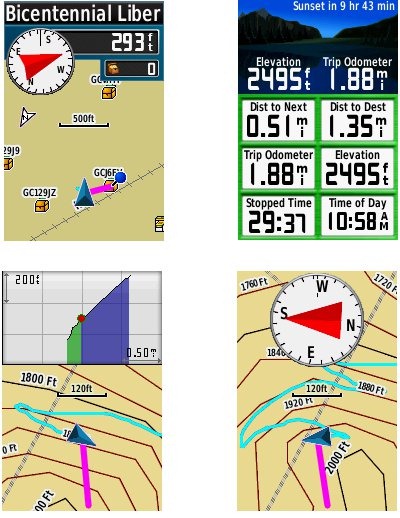
Track navigation
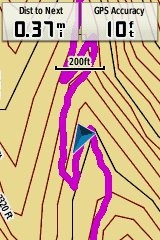 With the GPSMAP 78, you can select a track to navigate and a route will be created. Waypoints are automatically generated for the high and low elevation points, start and finish; these and any user waypoints along the track are added to the route. I’m a heavy user of track navigation. If I head out for a trail I’ve never traveled before, I do a search online for tracks (favorite search terms are .gpx, gps, trail name, and park name) and load the track to the device. One advantage of this new track navigation feature is that, unlike typical backcountry route navigation, you’ll get an estimate of actual trail distance rather than “as the crow flies” mileage. Screenshot at right.
With the GPSMAP 78, you can select a track to navigate and a route will be created. Waypoints are automatically generated for the high and low elevation points, start and finish; these and any user waypoints along the track are added to the route. I’m a heavy user of track navigation. If I head out for a trail I’ve never traveled before, I do a search online for tracks (favorite search terms are .gpx, gps, trail name, and park name) and load the track to the device. One advantage of this new track navigation feature is that, unlike typical backcountry route navigation, you’ll get an estimate of actual trail distance rather than “as the crow flies” mileage. Screenshot at right.
Paperless Geocaching
The 78 series is set up for full paperless geocaching support, meaning you can see the description, logs, and hint, and you can log your attempt (find, DNF, etc.) for later transfer back to geocaching.com. Speaking of which, full access to these features requires a premium membership at geocaching.com. Shown below, clockwise from top left: closest geocaches, geocache description, map with geocaching dashboard, recent logs.
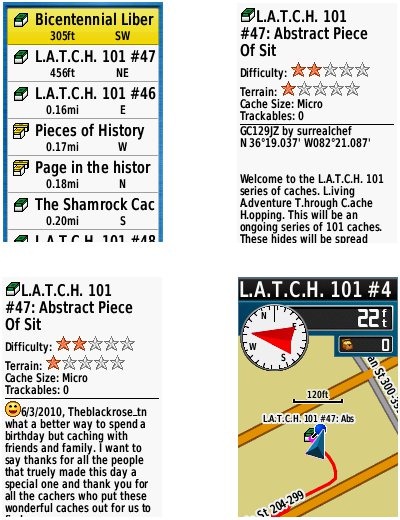
Other features of note
Most of the following aren’t that new, but they are worth mentioning anyway:
Route, Track and Waypoint management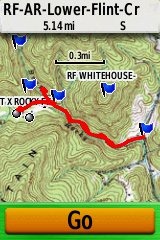
The GPSMAP 78 series has excellent route, track and waypoint management tools, including:
- Waypoints – The ability to project a waypoint, average location, set proximity alerts, and to reposition a waypoint at your current location.
- Tracks – You can choose to hide or show multiple tracks on the map, view an elevation plot, and give them a custom color (17 colors are available). The image at the right shows a track in red (a record of a previous trip). The color of the active track may also be changed. There’s a good thread at the GPSMAP wiki that delves more into track archiving and storage.
- Routes – You can view a map of the entire route, edit the route, reverse it and view an elevation plot.
Ability to utilize free maps
One of the most awesome things about Garmin mapping units is the huge number of free maps available. My favorite site for these is http://gpsfiledepot.com where you can find 1:24,000 scale vector topo maps for most states. An example is shown below, at left. If you want shaded relief though (shown at right), you’ll need to go with Garmin’s own product, either Topo US 100K or their new 1:24,000 scale series.
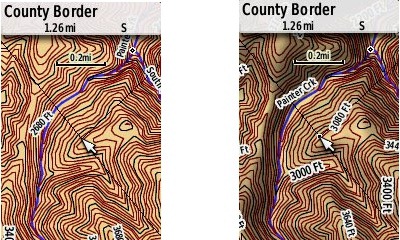
Auto use
While I would prefer the Oregon 450 as a dual use unit, due to its touch screen, the 78 series is capable of giving turn-by-turn directions when loaded with City Navigator maps.
Garmin GPSMAP 78 shortcuts
I imagine there are more, but here’s a couple of tips:
- Use the zoom buttons to jump a full page in a menu
- When entering a name, the zoom buttons will switch between keypads
Garmin GPSMAP 78 series performance
I was very impressed with tracklogs from the Garmin GPSMAP 78 series. A couple of representative tracks from the 78s are shown below. Tracks were recorded on the 78s and my 60CSx, with both set to a track point interval of 5 seconds. Recordings were made out and back, on foot, with the 78s in my right hand, and the 60CSx in my left. This meant that one unit may have been closer to a cut slope on the trip up, but the other unit was in this position on the trip down.
The first image shows a section of the Appalachian Trail laden with switchbacks. The 60CSx is in blue, the 78s in red. Both units performed reasonably well, although the 60CSx seemed a bit worse in terms of maximum tracklog separation – the distance between tracks recorded by it going up compared to coming down, which reached up to 70’ for the 60CSx, vs. around 50’ for the 78s.

The image below shows another out and back, on a day that probably saw a more favorable satellite constellation. Again, the 78s is in red, the 60CSx is in blue.

Despite the apparently clean tracklogs and similar track separation shown by both units that day, I was impressed by how little wandering there was for the 78s when stopped, as compared to the 60CSx. I’ve blown up the start of the trip at the trailhead (below left) and the turn around / break point (below right).
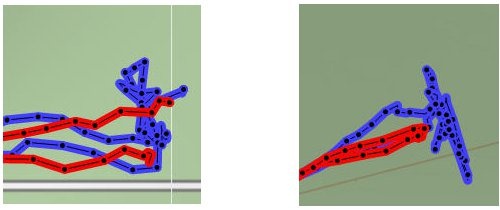
Reporting of position, as evidenced by these tracklogs was extremely impressive. I did notice a definite degradation when the unit was held vertically, likely due to its patch antenna. I’m providing links below where you can download the .gpx or .gdb (MapSource) files below.
- 78s-Chestoa.gpx
- 60CSx-Chestoa.gpx
- 78s-Flint-Cr.gpx
- 60CSx-Flint-Cr.gpx
- 78s-test-Flint-Cr.gdb
- 78s-test-Chestoa.gdb
While the tracklogs looked great, I did see inaccuracies in terms of reported elevation gain. Following one outing where I anticipated a gain of around 1000’, the 78s reported 1512’, compared to 876’ on my 60CSx and 899’ on my Oregon. On another outing, the elevation gain was 366’ according to my 60CSx, but came in at 821’ on the 78. This appears to be similar to a bug that was recently fixed on the Oregon series (although it seems to have reappeared with the latest beta). Hopefully an early firmware update will resolve it here.
Garmin GPSMAP 78 pros
- Excellent menu setup; fast access to features
- Bright screen
- It floats
- Ability to load Garmin custom maps and BirdsEye aerial imagery
- Paperless geocaching
- Advanced track navigation
- Lightweight
- Chipset firmware seems very mature, resulting in highly accurate tracklogs
Garmin GPSMAP 78 cons
- Small, low resolution screen
- Text entry more difficult than on a touchscreen Oregon
- Inaccurate elevation gain reports
- Does not work with standard mounts
- Bulky
- Patch antenna adversely impacts accuracy when unit is held vertically
Conclusion and recommendations
Highly recommended; this is the best marine handheld series currently made by Garmin. One reason I say this is due to the bright screen, which should outperform any touchscreen in the kind of bright conditions you’re likely to find on the water.
Garmin has a clear winner with the 62/78 series. The interface is awesome; the Page Ribbon has some clear advantages. Add to this Garmin custom maps, BirdsEye aerial imagery, paperless caching and more.
More Garmin GPSMAP 78 reviews
- Consumer-authored Garmin GPSMAP 78 reviews
have been posted at Amazon
- Geocacher reviews of the Garmin 78
- I’ll be posting more hands on GPS reviews as they appear, but in the meantime, here are some…
Other Garmin GPSMAP 78 resources
- A PDF version of the Garmin GPSMAP 78 owners manual
- This chart will show you how the Garmin GPSMAP 78 compares to other Garmin handhelds
- A Garmin GPSMAP 62 and 78 series wiki
- The official Garmin GPSMAP 78 web page
Compare prices on the Garmin GPSMAP 78 at these merchants:
- Check the current Garmin GPSMAP 78 2.6-Inch Marine GPS Navigator and Worldwide Chartplotter
price at Amazon
- Find the Garmin GPSMAP 78 at GPS City, one of our favorite small vendors
- Buy the Garmin GPSMAP 78 Color Hand Held GPS Receiver
at Tiger GPS
- Get the Garmin GPSMAP 78
from J&R Computer/Music World
- Check out the deal on the Garmin Gpsmap 78
at Cabelas
- Buy the GPSMAP 78
direct from Garmin
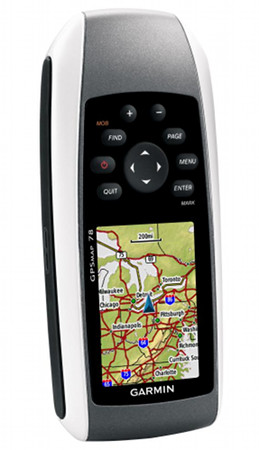


Hi, I was wondering if you could tell me how much degradation there was when the unit was held vertically? I’m interested in comparing the performance to the GPSmap 76Cx which I use at present (which I believe has a quad-helix antenna as opposed to the patch antenna which is used in the 78 series). I would also like to know how well the 78 series is likely to cope with dense foliage?
My 78 series testing was done over two years ago, so I don’t really recall. But I think it does very well under dense foliage. You’ll probably see much less track wandering/spidering while standing stil than you do on the 76Cx.
Hi Rich
I return to your site a couple of times a year to check on the latest handhelds. I am still waiting to buy a handheld for use on my sailing canoe but haven’t yet found one that seems to suit my wishes. I am most familiar with Garmin GPSs. In the above GPSMAP 78 review you write: “Highly recommended; this is the best marine handheld series currently made by Garmin.” However, the “small, low resolution screen” is what put me off two years ago and still does. I was wondering if your recommendation takes into account new handhelds released in the last two years? Specifically the Montana 600. Does the 78 series still win for marine use due to the brighter screen? Have you ever done any on-water testing? It seems to be a choice between a small/bright screen or a bigger/dimmer screen. I would love to know which is more legible on the water, especially for short-sighted users (specs are not very practical on the water).
I’m not clear on what is new in this review as you comment that you “78 series testing was done over two years ago”. What did you update in this GPSMAP 78 review?
Really enjoy your site. Thanks for all the work.
I did a hands on review of the 78s a couple of years ago but recently posted this page for the 78. I don’t think the small, low res screen is a big issue. My favorite handheld is my 62s. I suspect the 78 will be brighter than the Montana on water. Hope this helps.
Good morning,
I´m from Brazil and we have office in miami and i need prices of GPSMAP78
Thanks
Luciano
I have been looking at GPS’s and doing a bit of home work on them , mostly Garmin models . I was thinking about the Etrex 10 and 20 models , and also other Garmin models . Coming to a conclusion , I thought spend a bit more , as my life will be depending on it , and buy new . Looking around web sites is always a bit time consuming , and mostly not all the information is not their . Also getting the right information from the right people , is my highest priority . And that is what I have found here , the right information , including the right person/people . Thanks so much for a wonderful review , as I really did enjoy it 100% .
I have a GPSMap 78sc. Can anyone tell me how to download , setup or create waypoints on my MAC computer and then download the data to my 78sc. Is there any software available to do this?